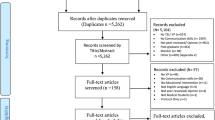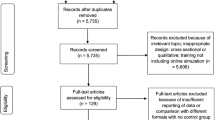Abstract
Problem presentation in problem-based learning can include the use of videos and interactive virtual patients. This review scopes the literature for this variation and what benefits or pitfalls there may be to their use. Themes indicate that videos and virtual patients may better prepare students for future difficult clinical interactions, while also increasing authenticity and memorability of cases. Findings are more inconsistent in determining whether they lead to clear knowledge or critical thinking gains. Despite inconsistent data, in an age where the use of technology is inevitable, the findings of this scoping review can inform future practice and guide innovation.

Similar content being viewed by others
Data Availability
All data generated or analyzed during this study are included in this published article (and its supplementary information files).
References
Servant-Miklos VF. Fifty years on: a retrospective on the world’s first problem-based learning programme at McMaster University Medical School. Health Profess Educ. 2019;5(1):3–12.
Barrows HS. Problem-based learning in medicine and beyond: a brief overview. New Dir Teach Learn. 1996;1996(68):3–12.
Berman NB, Durning SJ, Fischer MR, Huwendiek S, Triola MM. The role for virtual patients in the future of medical education. Acad Med. 2016;91(9):1217–22.
Ellaway RH. Technology-enhanced learning. In: Swanwick T, Forrest K, O’Brien BC, editors. Understanding medical education: evidence, theory, and practice. Hoboken: Wiley-Blackwell; 2019. p. 139–49.
Charlin B, Mann K, Hansen PB. The many faces of problem-based learning: a framework for understanding and comparison. Med Teach. 1998;20(4):323–30.
Arksey H, O’Malley L. Scoping studies: towards a methodological framework. Int J Soc Res Methodol. 2005;8(1):19–32.
Levac D, Colquhoun H, O’Brien KK. Scoping studies: advancing the methodology. Implement Sci. 2010;5(1):69.
Hepplestone S, Holden G, Irwin B, Parkin HJ, Thorpe L. Using technology to encourage student engagement with feedback: a literature review. Res Learn Technol. 2011;19(2).
Jaskiewicz W, Tulenko K. Increasing community health worker productivity and effectiveness: a review of the influence of the work environment. Hum Resour Health. 2012;10(1):38.
Pham MT, Rajić A, Greig JD, Sargeant JM, Papadopoulos A, McEwen SA. A scoping review of scoping reviews: advancing the approach and enhancing the consistency. Res Synth Methods. 2014;5(4):371–85.
Clarke V, Braun V. Using thematic analysis in counselling and psychotherapy research: a critical reflection. Couns Psychother Res. 2018;18(2):107–10.
Basu Roy R, McMahon GT. Video-based cases disrupt deep critical thinking in problem-based learning. Med Educ. 2012;46(4):426–35.
Chan LK, Patil NG, Chen JY, Lam JC, Lau CS, Ip MS. Advantages of video trigger in problem-based learning. Med Teach. 2010;32(9):760–5.
De Leng BA, Dolmans DH, Van de Wiel MW, Muijtjens A, Van Der Vleuten CP. How video cases should be used as authentic stimuli in problem-based medical education. Med Educ. 2007;41(2):181–8.
Ghanchi NK, Khan S, Afridi A, Sajid S, Afzal S, Ahmed I, et al. Video or paper for delivery of problem-based learning cases? Med Educ. 2013;47(11):1131.
Hassoulas A, Forty E, Hoskins M, Walters J, Riley S. A case-based medical curriculum for the 21st century: the use of innovative approaches in designing and developing a case on mental health. Med Teach. 2017;39(5):505–11.
Ikegami A, Ohira Y, Uehara T, Noda K, Suzuki S, Shikino K, et al. Problem-based learning using patient-simulated videos showing daily life for a comprehensive clinical approach. Int J Med Educ. 2017;8:70–6.
Kamin C, Deterding R, Lowry M. Student’s perceptions of a virtual PBL experience. Acad Med. 2002;77(11):1161–2.
Kamin C, O’Sullivan P, Deterding R, Younger M. A comparison of critical thinking in groups of third-year medical students in text, video, and virtual PBL case modalities. Acad Med. 2003;78(2):204–11.
Lajoie SP, Hmelo-Silver CE, Wiseman JG, Chan LK, Lu J, Khurana C, et al. Using online digital tools and video to support international problem-based learning. Interdiscip J Problem-Based Learning. 2014;8(2):60–75.
Ellaway RH, Poulton T, Jivram T. Decision PBL: a 4-year retrospective case study of the use of virtual patients in problem-based learning. Med Teach. 2015;37(10):926–34.
Kleinert R, Heiermann N, Plum PS, Wahba R, Chang D-H, Maus M, et al. Web-based immersive virtual patient simulators: positive effect on clinical reasoning in medical education. J Med Internet Res. 2015;17(11):e263.
Poulton T, Conradi E, Kavia S, Round J, Hilton S. The replacement of ‘paper’ cases by interactive online virtual patients in problem-based learning. Med Teach. 2009;31(8):752–8.
Poulton T, Ellaway RH, Round J, Jivram T, Kavia S, Hilton S. Exploring the efficacy of replacing linear paper-based patient cases in problem-based learning with dynamic Web-based virtual patients: randomized controlled trial. J Med Internet Res. 2014;16(11):e240.
Raupach T, Muenscher C, Anders S, Steinbach R, Pukrop T, Hege I, et al. Web-based collaborative training of clinical reasoning: a randomized trial. Med Teach. 2009;31(9):e431–e7.
Smith SR, Cookson J, Mckendree J, Harden RM. Patient-centred learning—back to the future. Med Teach. 2007;29(1):33–7.
Sobocan M, Turk N, Dinevski D, Hojs R, Pecovnik Balon B. Problem-based learning in internal medicine: virtual patients or paper-based problems? Intern Med J. 2017;47(1):99–103.
Lee MT, Jacobs JL, Kamin CS. Video-enhanced problem-based learning to teach clinical skills. Med Educ. 2006;40(5):473–4.
McLean M, Brazil V, Johnson P. How we “breathed life” into problem-based learning cases using a mobile application. Med Teach. 2014;36(10):849–52.
Woodham LA, Ellaway RH, Round J, Vaughan S, Poulton T, Zary N. Medical student and tutor perceptions of video versus text in an interactive online virtual patient for problem-based learning: a pilot study. J Med Internet Res. 2015;17(6):e151.
Yoon BY, Choi I, Choi S, Kim T-H, Roh H, Rhee BD, et al. Using standardized patients versus video cases for representing clinical problems in problem-based learning. Korean J Med Educ. 2016;28(2):169–78.
Knowles MS, Holton III EF, Swanson RA. The adult learner: the definitive classic in adult education and human resource development. Routledge; 2014.
Daudt HM, van Mossel C, Scott SJ. Enhancing the scoping study methodology: a large, inter-professional team’s experience with Arksey and O’Malley’s framework. BMC Med Res Methodol. 2013;13(1):48.
Code Availability
Not applicable.
Author information
Authors and Affiliations
Corresponding author
Ethics declarations
Conflict of Interest
The authors declare that they have no conflict of interest.
Additional information
Publisher’s Note
Springer Nature remains neutral with regard to jurisdictional claims in published maps and institutional affiliations.
Electronic supplementary material
ESM 1
(DOCX 14 kb)
Glossary
- Scoping review
-
a research approach that aims to “map the literature on a particular topic or research area and provide an opportunity to identify key concepts; gaps in the research; and types and sources of evidence to inform practice, policymaking, and research” [33].
- Triggers
-
means of problem presentation within problem-based learning [13].
- Virtual patients (VPs)
-
“interactive computer simulation of real-life clinical scenarios for the purpose of healthcare and medical training, education, or assessment” [21].
Rights and permissions
About this article
Cite this article
Noverati, N., R. Naro, G., J. Fischer, R. et al. Using Video and Virtual Patients in Problem-Based Learning: a Scoping Review. Med.Sci.Educ. 30, 1685–1691 (2020). https://doi.org/10.1007/s40670-020-01108-7
Accepted:
Published:
Issue Date:
DOI: https://doi.org/10.1007/s40670-020-01108-7




